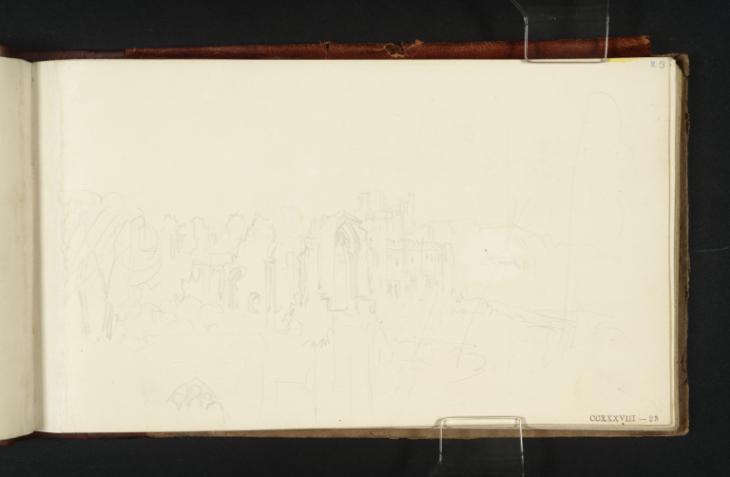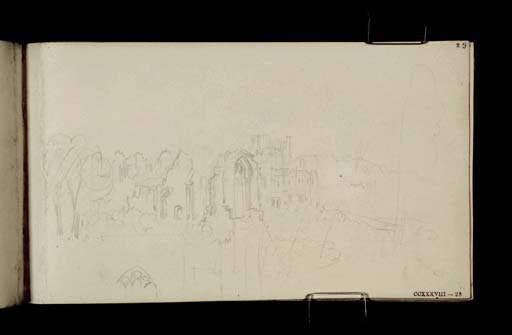J.M.W. Turner
>
1830-35 Annual tourist
>
Midlands 1830
>
Kenilworth Sketchbook
>
Artwork
Joseph Mallord William Turner The Ruins of Dudley Priory, with Priory Hall Beyond 1830
Image 1 of 2
Joseph Mallord William Turner,
The Ruins of Dudley Priory, with Priory Hall Beyond
1830
Joseph Mallord William Turner 1775–1851
Folio 23 Recto:
The Ruins of Dudley Priory, with Priory Hall Beyond 1830
D22016
Turner Bequest CCXXXVIII 23
Turner Bequest CCXXXVIII 23
Pencil on white wove paper, 120 x 203 mm
Inscribed by John Ruskin in blue ink ‘23’ top right
Stamped in black ‘CCXXXVIII – 23’ bottom right
Inscribed by John Ruskin in blue ink ‘23’ top right
Stamped in black ‘CCXXXVIII – 23’ bottom right
Accepted by the nation as part of the Turner Bequest 1856
References
1909
A.J. Finberg, A Complete Inventory of the Drawings of the Turner Bequest, London 1909, vol.II, p.730, CCXXXVIII 23, as ‘Ruins, probably at Ashby-de-la-Zouch’.
As part of unpublished Turner research informed by local knowledge, Dr Bernard Richards has identified the ruins as Dudley Priory.1 Originating in the twelfth-century,2 the ruins now stand off The Broadway in Priory Park; only the buildings on the south side of the priory complex survive above ground level. Turner’s viewpoint corresponds with Pagenel Drive, looking north-west to the ruins in Priory Park, which remain much the same. In the distance beyond the arch at the centre stands the castellated Priory Hall, built in 1825 by the Earl of Dudley, which now serves as the town’s register office.3 It is obscured by trees from this viewpoint. There is a detail of window tracery towards the bottom left. Finberg was incorrect in his suggestion that the subject was Ashby-de-la-Zouch Castle, for which see under folio 21 verso (D22012; Turner Bequest CCXXXVIII 21).
The town of Dudley, now in the West Midlands, was formerly in an enclave of Worcestershire at the southern end of Staffordshire, about eight miles north-west of central Birmingham. Dudley Castle, on a hill north of the centre of the town, originated in 1070. In the 1530s, John Dudley (later Duke of Northumberland) made additions including the Renaissance-style Sharington Range. Elizabeth I visited in 1575; her favourite, Robert Dudley, Earl of Leicester, the Duke of Northumberland’s son, made comparable changes at Kenilworth Castle for the queen’s visits at that time (for Turner and Kenilworth, see under folio 29 recto; D22028). Dudley’s fortifications were slighted in 1647 during the Civil War, and the Sharington Range was badly damaged by fire in 1750, leaving the site as Turner saw it and largely as it survives today.4 In 1937 Dudley Zoo was opened, on terraced slopes encompassing the castle, with contrasting Modernist structures by Berthold Lubetkin and the Tecton Group. The limestone hill, an ancient sea-bed, is known for its fossils and is riddled with former mine workings,5 as is Wren’s Nest Hill, nearby to the north-west. The latter is now a National Nature Reserve, and its wooded slopes are protected following a history of intensive limestone mining and quarrying for building stone and lime used in mortar and fertiliser and as a purifying flux in the blast furnaces of the local iron industry.6
William S. Rodner has written extensively on Turner’s experience and interpretation of Dudley,7 which was informed as much by the extensive and expanding local industries of the surrounding Black Country as by the historical associations of the town. Turner’s watercolour Dudley, Worcestershire of about 1832 (Lady Lever Art Gallery, Port Sunlight),8 engraved in 1835 for the Picturesque Views in England and Wales (Tate impressions: T05097, T06113, T06114), combines moonlit castle ruins and churches on the skyline with a busy foreground comprising a canal and industrial buildings including smoking chimneys and furnaces. The drawing on folios 67 verso–68 recto (D22102, D22103; Turner Bequest CCXXXVIII 65a, 66) is probably the main source for the watercolour, albeit with its rural foreground transformed, while two ‘colour beginnings’ (Tate D25250, D25350; Turner Bequest CCLXIII 128, 228) are possibly related. Frank Milner’s entry on the Port Sunlight watercolour includes a summary of later writings on the watercolour by John Ruskin and others, and quotes the England and Wales letterpress, noting ‘mines of coal, iron, stone and ironstone’ and ‘the production of ‘iron, nails, glass and fire irons’.9 The 1834 Ordnance Survey map of the area shows the countryside thick with collieries, lime works, furnaces and ironworks, with the junction of the Birmingham and Dudley Canals north-east of the castle at Tipton, and Dudley Canal passing through a long tunnel west of the castle and town, emerging to the south-west.10 The Black Country Living Museum by the canal at Tipton records this heritage in a area since much developed.
Following Finberg,11 Eric Shanes has listed folios 62 recto–70 recto (D22091–D22107; Turner Bequest CCXXXVIII 60–68) as Dudley subjects;12 Frank Milner extended the range to folios 60 verso–72 recto (D22088–D22111; Turner Bequest CCXXXVIII 58a–70).13 The present page now stands as the first of the identified Dudley views in this sketchbook, the others being the verso, folios 24 recto and 24 verso–25 recto (D22017–D22020), and folios 59 recto–72 recto (D22085–D22111; Turner Bequest CCXXXVIII 57–70). Folio 47 verso (D22064) may be another, as it appears to relate to the drawings on folios 60 verso and 61 recto (D22088, D22089; Turner Bequest CCXXXVIII 58a, 59); all three drawings are as yet not firmly identified as Dudley subjects. Whether they are or not, the thirty or so pages here represent the most intensive coverage of any Midlands subject in the Kenilworth book, and there are also many views of the Dudley area in the contemporary Birmingham and Coventry sketchbook (see under Tate D22395; Turner Bequest CCXL 39), which includes more details of the industrial aspects of the area which informed the watercolour.
Matthew Imms
August 2013
See ‘Priory Park, Dudley’, Midlands Heritage, accessed 24 June 2013, http://www.midlandsheritage.co.uk/miscellaneous-heritage/3445-priory-park-dudley.html .
See ‘Dudley Castle’, Dudley Zoological Gardens, accessed 22 July 2013, http://www.dudleyzoo.org.uk/around-dzg/dudley-castle .
See ‘History of the Zoo’ and ‘Tectons’, Dudley Zoological Gardens, accessed 22 July 2013, http://www.dudleyzoo.org.uk/around-dzg/history-zoo , http://www.dudleyzoo.org.uk/around-dzg/tectons .
See ‘Wren’s Nest National Nature Reserve’, Dudley Metropolitan Borough Council, accessed 11 July 2013, http://www.dudley.gov.uk/resident/environment/countryside/nature-reserves/wrens-nest-nnrwrens-nest-nnr/ ; and ‘The Geology of Wren’s Nest Nature Reserve’, BGCS: The Black Country Geological Society, accessed 11 July 2013, http://www.bcgs.info/pdf_files/wrens_nest_leaflet_2009.pdf .
See William S. Rodner, ‘Turner’s “Dudley”: Continuity, Change and Adaptability in the Industrial Black Country’, Turner Studies, vol.8, no.1, Summer 1988, pp.32–40; and Chapter 4, ‘Urban Industrialism: Leeds, Newcastle, Shields and Dudley’ in William S. Rodner, J.M.W. Turner: Romantic Painter of the Industrial Revolution, Berkeley and London 1997, pp.86–121, and pp.104–21 in particular, based on the Turner Studies article.
Frank Milner, J.M.W. Turner: Paintings in Merseyside Collections: Walker Art Gallery; Sudley Art Gallery; Williamson Art Gallery; Lady Lever Art Gallery; Liverpool University Art Gallery, Liverpool 1990, p.53 under no.26; see also subsequent accounts in James Hamilton, Turner and the Scientists, exhibition catalogue, Tate Gallery, London 1998, pp.97–8, James Hamilton, Turner’s Britain, exhibition catalogue, Gas Hall, Birmingham Museums & Art Gallery 2003, p.24, and Ian Warrell, in Warrell (ed.), Franklin Kelly and others, J.M.W. Turner, exhibition catalogue, National Gallery of Art, Washington 2007, p.123.
How to cite
Matthew Imms, ‘The Ruins of Dudley Priory, with Priory Hall Beyond 1830 by Joseph Mallord William Turner’, catalogue entry, August 2013, in David Blayney Brown (ed.), J.M.W. Turner: Sketchbooks, Drawings and Watercolours, Tate Research Publication, September 2014, https://www


